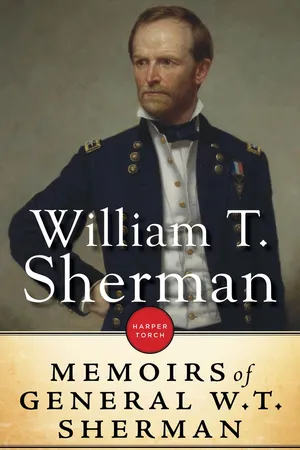
- 913 pages
- English
- ePUB (mobile friendly)
- Available on iOS & Android
The Memoirs Of General William T. Sherman
About this book
First published in 1875, General William T. Sherman's memoir was one of the first from the Civil War, and was offered to the public because, as Sherman wrote in his dedication, "no satisfactory history" of the war was yet available.
Although the Memoirs have been revised and corrected many times over the years, Sherman, famously, never changed the original text of his recollections. He was not an historian, he said, and invited "any witness who may disagree with me should publish his own version of [the] facts…"
HarperTorch brings great works of non-fiction and the dramatic arts to life in digital format, upholding the highest standards in ebook production and celebrating reading in all its forms. Look for more titles in the HarperTorch collection to build your digital library.
Frequently asked questions
- Essential is ideal for learners and professionals who enjoy exploring a wide range of subjects. Access the Essential Library with 800,000+ trusted titles and best-sellers across business, personal growth, and the humanities. Includes unlimited reading time and Standard Read Aloud voice.
- Complete: Perfect for advanced learners and researchers needing full, unrestricted access. Unlock 1.4M+ books across hundreds of subjects, including academic and specialized titles. The Complete Plan also includes advanced features like Premium Read Aloud and Research Assistant.
Please note we cannot support devices running on iOS 13 and Android 7 or earlier. Learn more about using the app.
Information
Volume I
Chapter I
From 1820 to the Mexican War (1820–1846)
Table of contents
- CONTENTS
- Author’s Note
- Preface to the Second Edition
- Volume I
- Volume II
- Appendix to Volume I
- About the Author
- About the Series
- Copyright
- About the Publisher